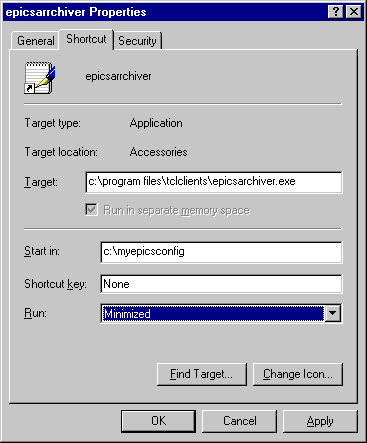
 |
epicsarchiver - Monitoring control system data. |
|---|
epicsarchiver is a Win32 program which acts as a TclServer client. It monitors a set of control system channels and makes channel value and unit information available to TclServer scripts. The epicsarchiver is installed on all of the Data U systems. This document describes:
epicsarchiver is installed on all of the Windows-2000 systems in the data U area. The software is installed in c:\program files\TclClients. If you are at one of these systems, please skip this section and go on to Configuration and Execution..
epicsarchiver is distributed as a windows installer at: \\win-cluster\cgroup\daqsoftware\epicsarchiver\TclEpics.exe. Run this program to start the installer. You will have to:
| Choose an installation directory | (defaults to c:\program files\tclclients) | |
| Choose a folder for the shortcut to the program on the start menu | (defaults to NSLCDaq) | |
| Start the installer. |
Unless your C: partition is nearly full, in most cases you can simply accept the defaults. You will need to know into which directory the client has been installed in order to configure it.
Top Other TclServer Clients Documentation Home
The epicsarchiver requires two configuration files:
We recommend that you build a desktop shortcut for your user which allows you to easily run a specific configuration of the epicsarchiver. Do this as follows:

Once you have finished the configuration process described below, first run the TclServer to which the epicsarchiver is configured to connect, and then double click your shortcut to start the archiver.
Top Other TclServer Clients Documentation Home
In c:\myepicsconfig, create a new file; epicsarchiver and use e.g. notepad to edit it. Lines in the files each set a parameter. The lines are of the form:
parametername=value
Where the allowed parameters are:
| Parameter Name | Contains | Recommended Value |
| FileIn | Name of channel file. | |
| FileLog | Name of file containing error information | Errorlog.txt |
| SleepTime | Number of seconds between channel reads. | |
| PortNumber | Tcp/Ip port on which the TclServer you will connect to is listening for connections. | 2703 |
| HostName | Name of system on which the TclServer to which you will be connecting is running. | |
| UpdateTime | Seconds between attempts to connect to the TclServer on connection failure. | 60 |
Top Other TclServer Clients Documentation Home
The channel file describes which set of channels will be monitored by epicsarchiver.exe. The name of this file should match the FileIn parameter set in the epicsarchiver.ini file. The format of this file is simple: Each line contains the name of a channel to monitor. You can use the notepad editor to create and save this file in your configuration directory.
Top Other TclServer Clients Documentation Home
To effectively use the epicsarchiver, you need to beg, borrow, steal, or write user interface scripts for the TclServer to which epicsarchiver is connected. This section provides information needed to write these scripts.
The epicsarchiver maintains two Tcl arrays indexed by channel name:
The array names Tcl command can be used to determine the set of channels which are being maintained. For example, supposed you have created a 'database' of english names in the array USEFUL_NAMES, indexed by the epics names; The following script fragment creates three label widgets for each monitored channel. The widgets will, when laid out display respectively the useful name of the widget if it is defined or else the EPICS name if not, the value of the channel and its units:
#
# Wait for channels to exist:
#
while {[info vars EPICS_DATA] == ""} {after 1000}
# Get the list of monitored channels alpha sorted:
set channels [lsort [array name EPICS_DATA]]
# build the widgets:
set wnum 0
foreach chan $channels {
if {[array name USEFUL_NAMES $chan] != ""} {
set Name $USEFUL_NAMES($chan)
} else {
set Name $chan
}
label .name$wnum -text "$Name" label .value$wnum -textvariable EPICS_DATA($chan) label .units$wnum -textvariable EPICS_UNIT($chan) incr wnum
}
Top Other TclServer Clients Documentation Home
Last Modified: February 22, 2002
by: fox@nscl.msu.edu
© Copyright NSCL 1999, All rights reserved